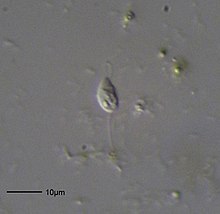Bodo saltans
| Bodo saltans | |
|---|---|

| |
| Bodo saltans | |
| Scientific classification | |
| Domain: | Eukaryota
|
| (unranked): | |
| Phylum: | |
| Class: | |
| Order: | |
| Genus: | |
| Species: | B. saltans
|
| Binomial name | |
| Bodo saltans Ehrenberg
| |
| Synonyms | |
|
Pleuromonas jaculans | |
Bodo saltans (alternatively known as Pleuromonas jaculans) is a free-living nonparasitic species of kinetoplastid flagellated phagotrophic protozoa that feed on bacteria.[1] Bodo saltans cells have been reported in freshwater and marine environments.
Bodo saltans is a single-celled bean-shaped organism 4 to 5 micrometers in length. It has two flagella: a short anterior projecting flagellum and a longer posterior-projecting flagellum without hairs (acronematic) that extends beyond the length of the cell. B. saltans secures itself to the substrate of its aquatic habitat by the tip of a posterior flagellum. Flexing of the posterior flagellum results in a twitching, jumping movement that is characteristic of this species. This type of movement appears similar to the undulating membrane of the sexually-transmitted pathogen Trichomonas vaginalis and can result in a false-positive diagnosis in cases where B. saltans is a contaminant in test samples, especially if a nonsterile saline solution has been used.
Phylogenetic analysis of the mitochondrial RNA editing process and inferred protein sequences in B. saltans appear to show that B. saltans diverged early on from the evolutionary line of kinetoplastids and that this species of bodonid is more closely related to the trypanosomatids than at least two species of parasitic bodonids of the genus Cryptobia.
Analysis based on the sequence of the topoisomerase II (topo II) gene provides evidence that B. saltans is a predecessor of the trypanosomatids. Commonly, the molecules of mitochondrial DNA in eukaryotes are circular and replication and transcription result in topological stress that is mitigated by enzymes called topoisomerases. Kinetoplastids possess a single mitochondrion with what is perhaps the most complex network of mitochondrial "kDNA" in small and large circular forms. As a consequence, mitochondrial genes for topoisomerases are available in high quantities that make it an attractive focus of genetic study. It is also the significance of the enzyme class of topoisomerases to the function of kinetoplastids that makes the topo genes a target for the medical treatment of trypanosomial and leishmanial diseases.
In one phylogenetic tree, the parasitic kinetoplastids included two separate groups of species – C. helicis and Trypanoplasma borreli in one group and the trypanosomatids in the other. The non-parasitic free-living B.saltans and B. uncinatus were distributed among the two groups, which implies that the bodonids such as B. saltans, may not have been predecessors of the parasitic species. Other studies show that the trypanosomatids evolved relatively late among the kinetoplastids and constitute a monophyletic group, but that the bodonids may be paraphyletic.
The species is known for being infected by a giant virus, the Bodo saltans virus, a member of the Mimiviridae family.[2]
References[]
- ^ Mitchell, G.C.; Baker, J.H.; Sleigh, M.A. (1988). "Feeding of a Freshwater Flagellate, Bodo saltans, on Diverse Bacteria". Journal of Eukaryotic Microbiology. 35 (2): 219–222. doi:10.1111/j.1550-7408.1988.tb04327.x.
- ^ Deeg, C.M.; Chow, E.C.T.; Suttle, C.A. (2018). "The kinetoplastid-infecting Bodo saltans virus (BsV), a window into the most abundant giant viruses in the sea". eLife. 7: e33014. doi:10.7554/eLife.33014. PMC 5871332. PMID 29582753.
Bibliography[]
- Blom, Daniël; Annett de Haan; Marlene van den Berg; Paul Sloof; Milan Jirku; Julius Lukes;, Rob Benne. 1998. RNA editing in the free-living bodonid Bodo saltans. Nucleic Acids Research Vol. 26, no. 5 1205-1213.
- Dolezel, D; M. Jirku, D.A. Maslov and J. Lukes. 2000. Phylogeny of the bodonid flagellates (Kinetoplastida) based on small-subunit rRNA gene sequences. International Journal of Systematic and Evolutionary Microbiology. Vol 50: 1943-1951
- Gaziová, Ivana and Julius Lukes. 2003. Mitochondrial and nuclear localization of topoisomerase II in the flagellate Bodo saltans (Kinetoplastida), a species with non-catenated kinetoplast DNA. Jan 16th JBC Papers, American Society for Biochemistry and Molecular Biology.
- Hänel K. 1979. Systematik und Ökologie der farblosen Flagellaten des Abwassers. Arch Protistenkd 121: 73-137.
- Hausmann, Klaus; Hulsmann, Norbert; Radek, Renate; Protistology (3rd Edition) 2003. E. Scheizerbart’sche Verlagsbuchhandlung.
- Lee, W. J.; Patterson, D.J. (1998). "Diversity and Geographic Distribution of Free-Living Heterotrophic flagellates". Protist. 149 (3): 229–243. doi:10.1016/s1434-4610(98)70031-8. PMID 23194636., updated with data from Al Qassab et al. (2002).
- Smith, A; Portsmouth, S; Curran, B; Warhurst, D; Kell, P; Saulsbury, N (2002). "TV or not TV?". Sex. Transm. Infect. 78 (3): 185–186. doi:10.1136/sti.78.3.185. PMC 1744461. PMID 12238649.
- Vørs N. 1992. Heterotrophic amoebae, flagellates and heliozoa from the Tvärminne area, Gulf of Finland, in 1988-1990.
Further reading[]
- Vaerewijck, Mario J.M.; Sabbe, Koen; Bare, Julie; Houf, Kurt (2011). "Occurrence and diversity of free-living protozoa on butterhead lettuce". International Journal of Food Microbiology. 147 (2): 105–111. doi:10.1016/j.ijfoodmicro.2011.03.015. PMID 21513995.
- Berriman, Matthew; Jackson, Andrew P; Quail, Michael A (9 December 2015). "Insights into the genome sequence of a free-living Kinetoplastid: Bodo saltans (Kinetoplastida: Euglenozoa)". BMC Genomics. 9 (1): 594. doi:10.1186/1471-2164-9-594. PMC 2621209. PMID 19068121.
- Mitchell, Gary C.; Baker, J. H.; Sleigh, M. A. (May 1988). "Feeding of a Freshwater Flagellate, Bodo Saltans, on Diverse Bacteria". The Journal of Protozoology. 35 (2): 219–222. doi:10.1111/j.1550-7408.1988.tb04327.x.
- Vaerewijck, Mario J.M.; Sabbe, Koen; Baré, Julie; Houf, Kurt (27 May 2011). "Occurrence and diversity of free-living protozoa on butterhead lettuce". International Journal of Food Microbiology. 147 (2): 105–11. doi:10.1016/j.ijfoodmicro.2011.03.015. PMID 21513995.
- Zirnstrein, Isabel (27 March 2012). "Eukaryotic Life in Biofilms Formed in a Uranium Mine". MicrobiologyOpen. 1 (2): 83–94. doi:10.1002/mbo3.17. PMC 3426414. PMID 22950016.
- Flegontov, Pavel; Votypka, Jan; Skalicky, Tomas (September 23, 2013). "Paratrypanosoma Is a Novel Early-Branching Trypanosomatid". Current Biology. 23 (18): 1787–1793. doi:10.1016/j.cub.2013.07.045. PMID 24012313.
- Kinetoplastids